treblehunter
Gold Member
- Joined
- Jun 18, 2013
- Messages
- 9,675
- Reaction score
- 11,296
- Golden Thread
- 0
- Location
- New Jersey
- Detector(s) used
- Minelab Excalibur II
XP Deus
Garrett pro pointer
XP Deus MI-6 pinpointer
- Primary Interest:
- All Treasure Hunting
I went to a different spot yesterday, back to an old church that is not left standing, the woods have long since claimed this area. A good friend of mine owns this 100 acres and deer hunts it, managing a tremendous deer herd there. Local legend has this place haunted, story goes that the KKK came one night and hung the black preacher there. It was supposed to have been part of the underground railroad also. I concentrated around two cellar holes where the iron and trash are very overwhelming. I took the long way back to the furthest cellar hole, walking through an area I never hit before, going along with absolutely silent woods with an occasional shotgun headstamp. When I got a sweet sound with a perfect not changing number that was screaming large silver. I had my Super sharp Leshe shovel and could barely find a place to sink it because of large roots. twenty minutes later I was up to my elbow going cautious so as not to hurt the target when this cool bell finally comes loose in my paw.
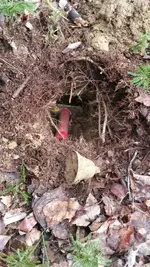
Only thing I found other than a 1951 licence plate at the cellar hole was a silver plated "Rogers" spoon. At the second hole I found a old copper spoon and then out pops this harmonica, I always wondered if I would find one whole.
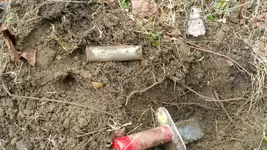
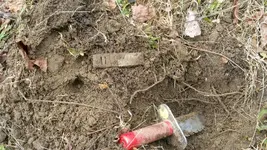
On the other side of the hole I found some more pieces of harmonica reed. It reads "C.A. Seydel Sohne" on my harmonica.
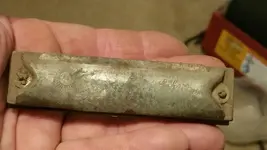
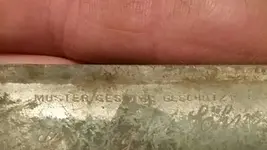
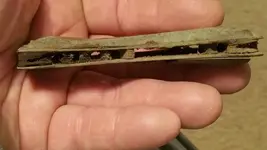
Here is a copy of the research of my harmonica.
History[edit]
In the 17th century the Seydel family were miners in Sachsenberg-Georgenthal/Saxony. When mining ceased in Saxony Vogtland, the brothers Johann Christian Seydel and Christian August Seydel began working as instrument makers. Both subsequently became approved harmonica makers. This was decreed by the court of Untersachsenberg on October 27, 1847. The certificate contains the first documented reference to the company, with Christian August Seydel being registered as the company founder. The factory was established in Klingenthal at the foot of the famous 'Aschberg' (literally ‘Ash Mountain’) and became one of the biggest harmonica factories in Saxony. In 1882, C.A. Seydel died, and his son Richard took over. One year later his brother Moritz joined them, and the company name changed to C.A.Seydel Söhne. (C.A. Seydel and Sons).
Seydel harmonicas[edit]
Blues (diatonic) models[edit]
1847 series - This series includes the Classic, Silver and Noble. All are similar but the classic has a wood comb, Silver has a plastic comb and the Noble has an aluminum comb with vented sides. The 160th anniversary model is similar but with luxury components and is only available in the key of C. Only 160 of these were produced. These models have stainless steel reeds.
Chromatic models[edit]
Saxony- This model is a chromatic harmonica with stainless steel reeds.
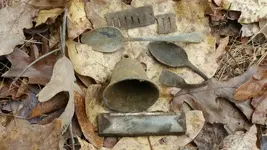
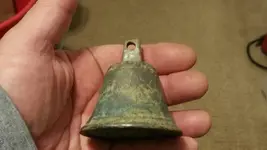
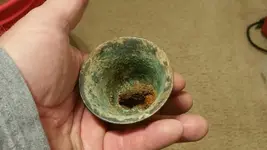
I hope you enjoyed my long winded tale and all my pix
HH & GL
Brad

Only thing I found other than a 1951 licence plate at the cellar hole was a silver plated "Rogers" spoon. At the second hole I found a old copper spoon and then out pops this harmonica, I always wondered if I would find one whole.


On the other side of the hole I found some more pieces of harmonica reed. It reads "C.A. Seydel Sohne" on my harmonica.



Here is a copy of the research of my harmonica.
History[edit]
In the 17th century the Seydel family were miners in Sachsenberg-Georgenthal/Saxony. When mining ceased in Saxony Vogtland, the brothers Johann Christian Seydel and Christian August Seydel began working as instrument makers. Both subsequently became approved harmonica makers. This was decreed by the court of Untersachsenberg on October 27, 1847. The certificate contains the first documented reference to the company, with Christian August Seydel being registered as the company founder. The factory was established in Klingenthal at the foot of the famous 'Aschberg' (literally ‘Ash Mountain’) and became one of the biggest harmonica factories in Saxony. In 1882, C.A. Seydel died, and his son Richard took over. One year later his brother Moritz joined them, and the company name changed to C.A.Seydel Söhne. (C.A. Seydel and Sons).
Seydel harmonicas[edit]
Blues (diatonic) models[edit]
1847 series - This series includes the Classic, Silver and Noble. All are similar but the classic has a wood comb, Silver has a plastic comb and the Noble has an aluminum comb with vented sides. The 160th anniversary model is similar but with luxury components and is only available in the key of C. Only 160 of these were produced. These models have stainless steel reeds.
Chromatic models[edit]
Saxony- This model is a chromatic harmonica with stainless steel reeds.



I hope you enjoyed my long winded tale and all my pix
HH & GL
Brad
Upvote
32




